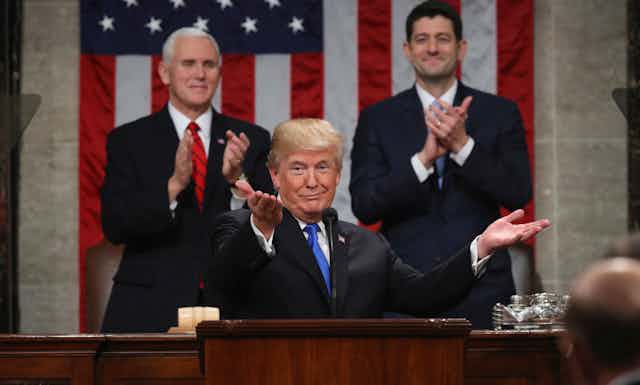Editor’s note: Removing a president from office is a two-step process. The first step is impeachment. That’s when members of the House indict, or charge, an official with an impeachable offense. Impeachment does not remove the president from office. That only happens if a second step is taken and the president is convicted of the alleged crimes.
Jacob Neiheisel, an assistant professor at the University at Buffalo, SUNY answers five questions about how impeachment works.
1. What sort of crime can lead to impeachment?
The U.S. Constitution states that the president can be removed from office after being both impeached and convicted for “Treason, Bribery, or other High Crimes and Misdemeanors.”
Treason is notoriously difficult to prove. For example, Aaron Burr – a former vice president – was caught stockpiling supplies and gathering a force to take over some of the lands that would eventually be obtained through the Louisiana Purchase. And yet, he still wasn’t convicted of treason.
To date, no president has been charged with bribery.
What exactly constitutes a “high crime” or “misdemeanor” has always been open to interpretation, but it is clear that partisan politics plays a role.
Scholars argue that Andrew Johnson, the first American president to be impeached, was targeted because of his “soft” approach to states of the former Confederacy during Reconstruction. The official reason was his violation of the Tenure of Office Act, which was later declared unconstitutional by the Supreme Court.
Articles of impeachment were brought against Bill Clinton for perjury, or lying under oath, and obstruction of justice, but there is little doubt that there was also a Republican desire to weaken Clinton’s presidency behind the charges.
Even Alexander Hamilton expected the process of impeachment to be overtly political. President Gerald Ford put the matter bluntly when he described an impeachable offense as “whatever a majority of the House of Representatives considers it to be at a given moment in history.”
2. How does the process work?
The process usually begins when a member of the House brings forth articles of impeachment. Last year, five Democrats in the House did just that.
Next comes a vote on the articles of impeachment by the House Judiciary Committee. The Judiciary Committee can choose to investigate the matter – or opt out, as they did in the case of the Clinton impeachment. The committee can then recommend for or against impeachment. Either way, their recommendation isn’t binding – meaning the House can impeach over their recommendation. The current chair of the committee, Virginia Republican Bob Goodlatte, is a strong supporter of the president, but he is set to retire in 2019.
Next comes a vote in the full House, with only a simple majority required.
If the House votes to impeach, the case is referred to the Senate for trial. The trial runs much like a criminal case, and witnesses can be called on either side. A supermajority, or two-thirds, of the Senate then has to vote to convict and remove the president from office.
Although two presidents, Andrew Johnson and Bill Clinton, have been impeached by the House, both avoided a conviction in the Senate and a resulting removal from office.
A common misconception is that the Supreme Court plays a major role in the proceedings. The chief justice does preside over impeachment trials in the Senate, but that is the court’s only role.
3. Republicans have a majority in the House and the Senate. Does that essentially make Trump bulletproof?
More or less.
Although it is possible that Republican members of Congress could join with Democrats in calling for Trump’s removal, as we saw happen in the run-up to Nixon’s resignation over the Watergate scandal, today’s polarized political environment makes such an occurrence unlikely absent clear and convincing evidence of major wrongdoing.
While Nixon’s impeachment was likely inevitable, with Democratic majorities in both houses of Congress in 1974, today substantial Republican defections from Trump would be essential to any movement toward impeachment.
Currently, there are 236 Republican House members. That means 22 Republicans would have to join with all of the Democrats in the House to impeach Trump. However, the 2018 midterm election could change this math if the Democrats pick up seats.
The articles of impeachment against Trump might look remarkably similar to those levied against Nixon and Clinton. The articles of impeachment drawn up by Democrats in November 2017 accuse the president of obstruction of justice related to the firing of FBI director James Comey, undermining the independence of the federal judiciary, accepting emoluments from a foreign government and other charges. Any attempt to accuse him of treason is extremely unlikely, in my opinion.
4. If the president is removed, who takes over? What would happen if the vice president was also implicated in the president’s crime?
If President Trump was removed from office, Vice President Mike Pence would be immediately sworn in. In the unlikely event that both the president and the vice president are impeached by the House and convicted by the Senate, Speaker of the House Paul Ryan would become president.
5. Can officers other than the president be impeached?
Absolutely. In fact, 15 federal judges have been impeached, although only eight have been removed from the bench. The most recent example was in 2010 when federal Judge G. Thomas Porteous was found guilty on multiple articles of impeachment by the U.S. Senate. Porteous was found to have accepted bribes from lawyers with dealings before his court.
This story updates a version posted on May 17, 2017.


